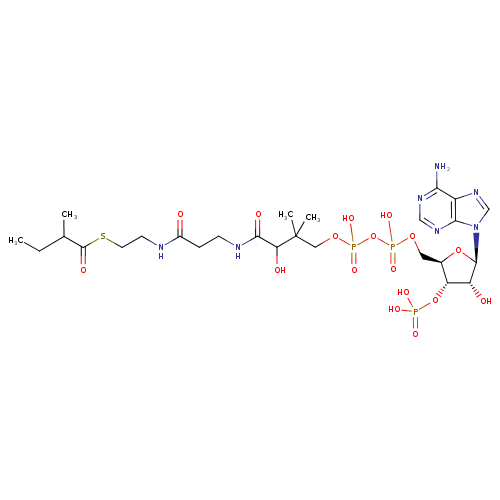|
Record Information |
|---|
| Version |
1.0 |
|---|
| Update Date |
1/22/2018 11:54:54 AM |
|---|
|
Metabolite ID | PAMDB120580 |
|---|
|
Identification |
|---|
| Name: |
2-methylbutanoyl-CoA |
|---|
| Description: | A short-chain, methyl-branched fatty acyl-CoA having 2-methylbutanoyl as the S-acyl group. |
|---|
|
Structure |
|
|---|
| Synonyms: | - 2-Methylbutanoyl-CoA
- 2-methylbutanoyl-coenzyme A
- 2-Methylbutyryl-CoA
- 2-methylbutyryl-coenzyme A
- S-(2-methylbutanoyl)-CoA
|
|---|
|
Chemical Formula: |
C26H40N7O17P3S |
|---|
| Average Molecular Weight: |
847.62 |
|---|
| Monoisotopic Molecular
Weight: |
851.1727 |
|---|
| InChI Key: |
LYNVNYDEQMMNMZ-UHFFFAOYSA-J |
|---|
| InChI: | InChI=1S/C26H44N7O17P3S/c1-5-14(2)25(38)54-9-8-28-16(34)6-7-29-23(37)20(36)26(3,4)11-47-53(44,45)50-52(42,43)46-10-15-19(49-51(39,40)41)18(35)24(48-15)33-13-32-17-21(27)30-12-31-22(17)33/h12-15,18-20,24,35-36H,5-11H2,1-4H3,(H,28,34)(H,29,37)(H,42,43)(H,44,45)(H2,27,30,31)(H2,39,40,41)/p-4 |
|---|
| CAS
number: |
6712-02-3 |
|---|
| IUPAC Name: | 3'- phosphoadenosine 5'- phosphoadenosine 5'- {3- {3- [(3R)- [(3R)- 3- 3- hydroxy- hydroxy- 2,2- 2,2- dimethyl- dimethyl- 4- 4- {[3- {[3- ({2- ({2- [(2- [(2- methylbutanoyl)sulfanyl]ethyl}amino)- methylbutanoyl)sulfanyl]ethyl}amino)- 3- 3- oxopropyl]amino}- oxopropyl]amino}- 4- 4- oxobutyl] dihydrogen diphosphate} oxobutyl] dihydrogen diphosphate} |
|---|
|
Traditional IUPAC Name: |
[(2R,3S,4R,5R)-5-(6-aminopurin-9-yl)-4-hydroxy-2-[({hydroxy[hydroxy(3-hydroxy-2,2-dimethyl-3-{[2-({2-[(2-methylbutanoyl)sulfanyl]ethyl}carbamoyl)ethyl]carbamoyl}propoxy)phosphoryl]oxyphosphoryl}oxy)methyl]oxolan-3-yl]oxyphosphonic acid |
|---|
| SMILES: | CCC(C)C(=O)SCCNC(=O)CCNC(C(O)C(COP([O-])(=O)OP([O-])(=O)OCC3(C(C(C(N2(C=NC1(C(=NC=NC=12)N)))O3)O)OP([O-])(=O)[O-]))(C)C)=O |
|---|
|
Chemical Taxonomy |
|---|
|
Taxonomy Description | This compound belongs to the class of chemical entities known as acyl coas. These are organic compounds containing a coenzyme A substructure linked to an acyl chain. |
|---|
|
Kingdom |
Chemical entities |
|---|
| Super Class | Organic compounds |
|---|
|
Class |
Lipids and lipid-like molecules |
|---|
| Sub Class | Fatty Acyls |
|---|
|
Direct Parent |
Acyl CoAs |
|---|
| Alternative Parents |
|
|---|
| Substituents |
- Coenzyme a or derivatives
- Purine ribonucleoside 3',5'-bisphosphate
- Purine ribonucleoside bisphosphate
- Purine ribonucleoside diphosphate
- Pentose phosphate
- Pentose-5-phosphate
- Ribonucleoside 3'-phosphate
- Beta amino acid or derivatives
- Glycosyl compound
- N-glycosyl compound
- Monosaccharide phosphate
- Organic pyrophosphate
- 6-aminopurine
- Pentose monosaccharide
- Imidazopyrimidine
- Purine
- Monoalkyl phosphate
- Aminopyrimidine
- Fatty amide
- Imidolactam
- Monosaccharide
- N-acyl-amine
- N-substituted imidazole
- Organic phosphoric acid derivative
- Alkyl phosphate
- Phosphoric acid ester
- Primary aromatic amine
- Pyrimidine
- Oxolane
- Azole
- Imidazole
- Heteroaromatic compound
- Amino acid or derivatives
- Thiocarboxylic acid ester
- Carboxamide group
- Carbothioic s-ester
- Secondary carboxylic acid amide
- Secondary alcohol
- Sulfenyl compound
- Thiocarboxylic acid or derivatives
- Organoheterocyclic compound
- Azacycle
- Oxacycle
- Carboxylic acid derivative
- Hydrocarbon derivative
- Alcohol
- Organic nitrogen compound
- Amine
- Organonitrogen compound
- Carbonyl group
- Organooxygen compound
- Organosulfur compound
- Organic oxygen compound
- Organopnictogen compound
- Primary amine
- Organic oxide
- Aromatic heteropolycyclic compound
|
|---|
| Molecular Framework |
Aromatic heteropolycyclic compounds |
|---|
| External Descriptors |
Not Available |
|---|
|
Physical Properties |
|---|
| State: |
Solid |
|---|
| Charge: | 0 |
|---|
|
Melting point: |
Not Available |
|---|
| Experimental Properties: |
| Property | Value | Reference |
|---|
| Melting Point | Not Available | Not Available | | Boiling Point | Not Available | Not Available | | Water Solubility | Not Available | Not Available | | LogP | Not Available | Not Available |
|
|---|
| Predicted Properties |
|
|---|
|
Biological Properties |
|---|
| Cellular Locations: |
Not Available |
|---|
| Reactions: | |
|---|
|
Pathways: |
- Valine, Leucine and Isoleucine Degradation pae00280
|
|---|
|
Spectra |
|---|
| Spectra: |
Not Available |
|---|
|
References |
|---|
| References: |
- Matich A, Rowan D (2007)Pathway analysis of branched-chain ester biosynthesis in apple using deuterium labeling and enantioselective gas chromatography-mass spectrometry. Journal of agricultural and food chemistry 55, Pubmed: 17335222
|
|---|
| Synthesis Reference: |
Not Available |
|---|
| Material Safety Data Sheet (MSDS) |
Not Available |
|---|
|
Links |
|---|
| External Links: |
|
|---|


